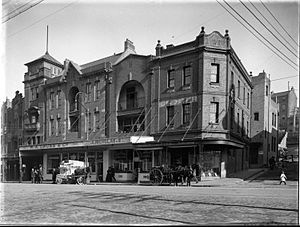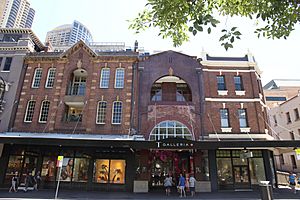145 George Street, The Rocks facts for kids
Quick facts for kids 145 George Street, The Rocks |
|
|---|---|

145 George Street, The Rocks, located on the corner of Globe Street; undated.
|
|
| Location | 145 George Street, The Rocks, City of Sydney, New South Wales, Australia |
| Built | 1892 |
| Owner | Property NSW |
| Official name: Shop and Residence; Currently part of Duty Free Store complex | |
| Type | State heritage (built) |
| Designated | 10 May 2002 |
| Reference no. | 1584 |
| Type | Shop |
| Category | Retail and Wholesale |
| Lua error in Module:Location_map at line 420: attempt to index field 'wikibase' (a nil value). | |
145 George Street, The Rocks is a special old building in The Rocks, a historic area in Sydney, Australia. It was built way back in 1892. Today, it's part of a big duty-free store complex. This building used to be a shop and a home. It's owned by Property NSW, which is a government group in New South Wales. Because it's so old and important, it was added to the New South Wales State Heritage Register on 10 May 2002. This means it's protected and its history is valued.
Contents
A Look Back: The History of 145 George Street
This spot has a long and interesting past! It was one of the first places in Sydney where Europeans settled.
Early Days and First Buildings
- Around 1807, two important people, Surgeon General John White and Captain William Raven, lived on this land.
- By 1835, a lady named Mrs. Underwood owned stone shops and houses here. Each had seven rooms.
- Later, around 1845, a two-storey brick house and shop with a shingle roof was built. It had five rooms and "every convenience," meaning it was very comfortable!
- At the corner of George and Globe Streets, another two-storey stone and brick house and store was built.
From Bowling Alley to Hotels
- In 1861, one of the buildings became a "Bowling Alley." Imagine bowling there over 160 years ago!
- By 1871, a public house called the "Nil Desperandum Hotel" opened.
- In 1882, more brick shops and homes were built nearby. One of these was close to the New York Hotel.
- Many buildings in the area were pulled down and rebuilt over the years.
Changes in the Late 1800s and Early 1900s
- In 1891, a building at the corner of Globe and George Streets was taken down.
- The current three-storey brick shop and home at 145 George Street was built in 1892. It was built for the Church of England.
- Around 1900, the government took over the area under the Observatory Hill Resumption Act. This was after a serious plague outbreak.
- More old buildings, like the New York Hotel, were demolished. New ones, like Quay Chambers, were built.
- In 1914, the current three-storey brick building at 147 George Street was built.
- In the 1970s, a grocery store called Downtown and Dyer operated on the ground floor of 145 George Street.
Modern Changes: The Duty Free Store
- In the 1980s, the Duty Free Shop Group complex was built. This meant the inside of 145 George Street was completely changed to fit the new complex.
- The area has been continuously used by people since 1788. The buildings you see today facing George Street were mostly built in the 1890s and early 1900s.
What 145 George Street Looks Like
This building is made of brick and has three floors. It sits right on the corner of Globe Street. It was built in 1892 as shops and offices.
Building Style and Features
- The building mixes two styles: late Victorian and early Federation.
- You can see Victorian details in the top part (the parapet), the window sills, and the special "keystones" above the windows.
- The use of face brick (bricks that are meant to be seen) is more typical of the Federation style.
- During the 1980s changes, part of the building on Globe Street was removed.
- The original awning (the cover over the shopfront) and the shopfront itself were rebuilt to look like they did originally.
- Inside, the building was changed a lot to create the modern duty-free store.
Condition of the Building
- As of 2001, experts thought that much of the very old archaeological remains under the building might have been destroyed by modern construction, like basement car parks.
- However, there might still be some old deposits left under the shops facing George Street.
How the Building Has Changed Over Time
- 1914: The New York Theatre was built nearby, but it was demolished in 1937.
- 1946: The Public Transport Commission bought this site.
- 1956: The City Circle Railway, which goes through the site, was opened.
- Late 1980s: A large commercial building was built behind 145-155 George Street. The fronts of the old buildings were kept but adapted for new uses.
- 1988: The DFS complex was built. This involved tearing down the back of the George Street buildings, removing the insides, and creating new shopfronts.
Why 145 George Street is Important
145 George Street is very important because of its history and its role in the community. It was built in 1893 and is part of a group of four historic buildings.
Historical Importance
- This site has been used by Europeans since 1788, making it a very old and continuously occupied place.
- It shows how The Rocks area changed over time, especially with new businesses in the late 1800s.
- It's linked to big events like the 1900 plague outbreak, which led to many buildings being rebuilt.
- It also shows how major transport projects, like the City Railway and the Cahill Expressway, changed the area.
- The building's interior was changed in the 1980s to make The Rocks a popular place for tourists.
- It's connected to Downton & Dyer, a well-known grocery business that started here in the late 1800s. This company still operates in Sydney today!
Design and Look
- The front of 145 George Street (the East Elevation) is a great example of a Victorian Regency style commercial building from the late 1800s.
- Even though the inside and back of the building were changed, the front still adds to the historic and beautiful look of George Street.
- A street awning, like the original, was put back. The shopfronts also look similar to those from the early 1900s.
Community and Streetscape Importance
- 145 George Street is part of a group of four old commercial buildings (145, 147, 149-151, and 153-155 George Street).
- These buildings together create a beautiful and historic streetscape. They are made of brick and stucco and fit well with the older buildings on George Street.
- They show how The Rocks was redeveloped in the late 1800s and early 1900s.
- The Rocks is a very special place in New South Wales, and this building helps keep its unique historic feel.
- The local community and people of New South Wales value The Rocks area greatly. Shopping has always been a big part of The Rocks, and this building continues that tradition.
Why It's Listed as Heritage
145 George Street was added to the New South Wales State Heritage Register on 10 May 2002 because it met several important criteria:
- It shows the pattern of history in New South Wales: It's a three-storey brick building from 1892-1893. It's on the corner of George Street (Australia's oldest street) and Globe Street (one of the earliest cross streets). A corner shop operated here for almost 90 years, changing from a small grocery store to a large wholesale business. It also shows how The Rocks became a major tourist spot in the 1980s.
- It's linked to important people or groups: It's connected to the Downton & Dyer grocery company, which started operating in The Rocks in 1879.
- It shows great design or technical skill: The group of four brick buildings, including 145 George Street, shows how commercial buildings looked around the turn of the century. They are a good example of Federation period architecture. They also show how the area changed due to maritime activities at Circular Quay.
- It has a strong connection to the community: The Rocks is very important to the community in Sydney and New South Wales. This building helps keep the historic character of The Rocks, which people value. It also continues the area's long history of shopping and retail.
- It represents a type of historic place: The shops in The Rocks show how the area has continuously been used for business, and how it has changed to focus on tourism. 145 George Street is a great example of these shop buildings that operated from the late 1800s until the late 1900s.


